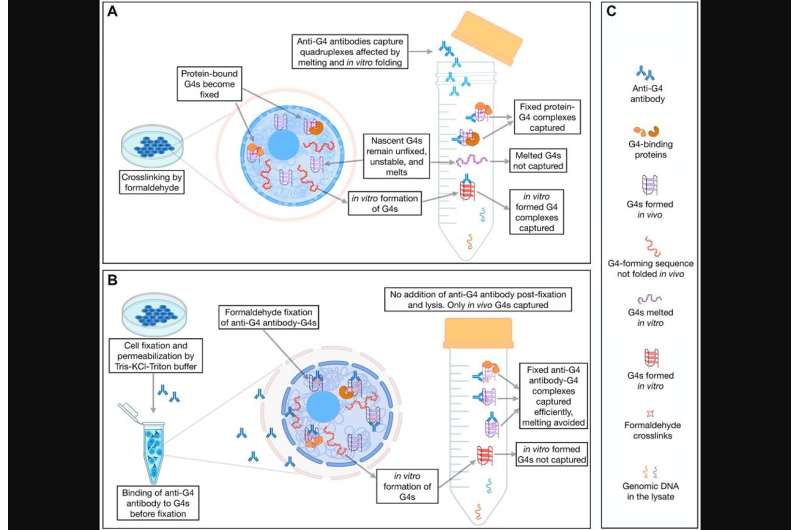This article has been reviewed according to Science X's editorial process and policies. Editors have highlighted the following attributes while ensuring the content's credibility:
fact-checked
peer-reviewed publication
proofread
A new antibody capture method reveals G-quadruplex landscape and its regulation

A new research paper was published in Oncotarget entitled, "G-quadruplex landscape and its regulation revealed by a new antibody capture method."
In this new study, researchers Subhamoy Datta, Manthan Patel, Chakkarai Sathyaseelan, Chandrama Ghosh, Akanksha Mudgal, Divyesh Patel, Thenmalarchelvi Rathinavelan, and Umashankar Singh from the Indian Institute of Technology Gandhinagar, Indian Institute of Technology Hyderabad, Queen Mary University of London, Bar-Ilan University, Medical University of Lublin, and the University of Helsinki discuss a secondary structure of DNA that has attracted wide interest, G-quadruplexes or G4s.
"Our understanding of DNA G-quadruplexes (G4s) from in vitro studies has been complemented by genome-wide G4 landscapes from cultured cells."
Conventionally, the formation of G4s is accepted to depend on G-repeats such that they form tetrads. However, genome-wide G4s characterized through high-throughput sequencing suggest that these structures form at a large number of regions with no such canonical G4-forming signatures. Many G4-binding proteins have been described with no evidence of any protein that binds to and stabilizes G4s.
"It remains unknown what fraction of G4s formed in human cells are protein-bound."
The G4-chromatin immunoprecipitation (G4-ChIP) method hitherto employed to describe G4 landscapes preferentially reports G4s that get crosslinked to proteins in their proximity. The current understanding of the G4 landscape is biased against the representation of G4s, which escape crosslinking as they are not stabilized by protein binding and are presumably transient.
The researchers reported a protocol that captures G4s from the cells efficiently without any bias as well as eliminates the detection of G4s formed artifactually on crosslinked sheared chromatin post-fixation. They discovered that G4s form sparingly at SINEs (short interspersed nuclear elements).
An application of this method shows that depletion of a repeat-binding protein CGGBP1 enhances net G4 capture at CGGBP1-dependent CTCF-binding sites and regions of sharp interstrand G/C-skew transitions.
"The AbC G4-ChIP presents a powerful technique to decipher the cellular G4 landscape and its regulation, and it has the potential to be adapted for discovering any DNA secondary structures genome-wide against which reliable antibodies are available."
More information: Subhamoy Datta et al, G-quadruplex landscape and its regulation revealed by a new antibody capture method, Oncotarget (2024). DOI: 10.18632/oncotarget.28564



















